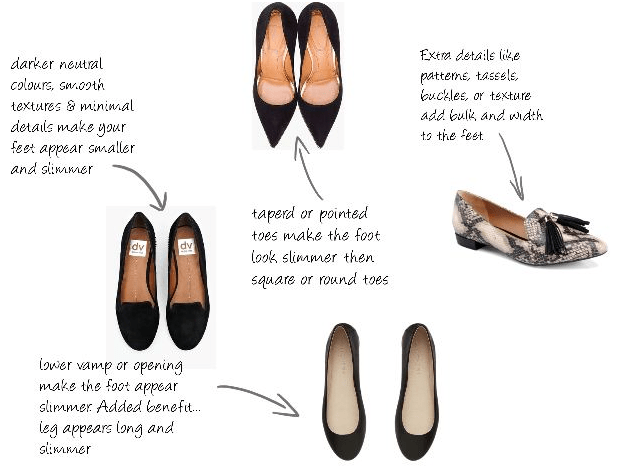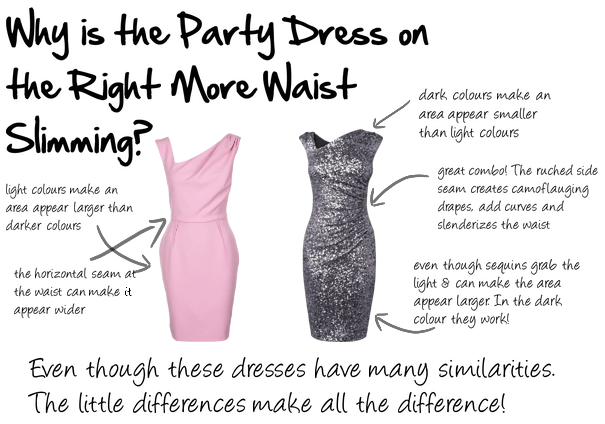
You may also be interested in:
How to Look Slimmer in Your Warm Colour Palette

You may also be interested in:
How to Look Slimmer in Your Warm Colour Palette
Change your ‘board room’ look, to a ‘party room’ look, by changing your top, jacket, shoes and accessories. Nothing say’s “party” like a little sparkle. And this year we are seeing sparkle on everything!
You may also be interested in:
When setting the table, the napkin may be placed in many locations of the place setting. Often you will see the napkin in the center of the place setting or dinner plate. However it is still considered traditional to place the napkin to the left of the forks, on the bread plate, or in the glass above the main-course knife (usually the water goblet or wine glass). It should always be accessible, and never placed under the utensils. Traditionally, the napkin is never grouped the utensils on the right side of the place setting.
The purpose of the napkin is to blot your mouth and wipe your fingers… not blow your nose, or spit food into. If you need to blow your nose use a tissue discretely at the table or go to the restroom. If you put something inedible into your mouth remove it discretely and place it on the side of your plate.
No – the napkin is not a bib. Although many cultures use napkins in many different ways, in North American culture, the only time a napkin is tucked under your chin is if you have received a plastic bib to eat crab in a restaurant or are eating spaghetti and your host has lead the way. In North America and most European cultures a dinner napkin is folded in half and placed on the lap of both legs with the fold facing towards you.
After you are seated the napkin goes on your lap. In a business setting the host leads the way and the guests follow. The traditional way in a social setting would be to wait for the female host to take the lead. If you’re like me, often when I am entertaining I am in the kitchen bringing out serving dishes instead of being served by staff. If this is the case, it would be polite to lead the way by inviting the guests to start. This would be an invitation for the guests to place their napkin on their lap.
Never crumple a cloth napkin onto your plate. When finished your meal the napkin is placed on the table to the left of your place setting. This is one indication that you are finished and your dishes can be removed. If you normally eat fast, slow down and pace yourself with the host and the rest of guests. If you are a slow eater, try to speed up to keep up the pace with the diners. Wait for the host to finish before leaving your napkin on the table.
Whether dining at the dining table or the coffee table, napkin etiquette remains the same. Napkin etiquette is for holiday dining and everyday dining… enjoy!
Kimberly Law, AICI CIP
Formal Dining for Informal People
Whether we like it or not, how we handle ourselves at the dining table can impact our business and social relationships. ‘Formal Dining for Informal People’, is a great reference tool to help you appear more confident and feel more at ease when dining casually or formally. This holiday season dine with confidence!
Want to learn more about Dining Etiquette? Buy the eBook ‘Formal Dining for Informal People’ today for only $10.00
You may also be interested in:
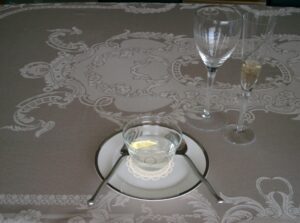 Although disposable finger towels are practical and often used in informal environments to cleanse the hands after eating messy food, in a formal environment you may be presented with a finger bowl as part of a dessert service or alone, even if your hands appear clean.
Although disposable finger towels are practical and often used in informal environments to cleanse the hands after eating messy food, in a formal environment you may be presented with a finger bowl as part of a dessert service or alone, even if your hands appear clean.In a traditional European dining environment the custom is for the fingerbowl is used after the dessert is eaten. If it has been presented to you as part of the dessert service, with both hands move the finger bowl and the doily together with both hands and place them in front of you after you have finished your dessert and your dessert plate has been removed. Dip the fingers of one hand into the water, and then dry them before dipping the fingers of the other hand into the water. After you are finished, place your napkin in loose folds to the left of your place setting.
For more on this topic buy eBook ‘Formal Dining for Informal People’
You may also be interested in:
Cutlery Etiquette How to Make a Great Impression
Dining Traditions vs. Casual Lifestyle
A dessert service consists of a dessert plate. On the plate, there will be a finger bowl placed on a doily in the centre of the plate, with a dessert fork to the left and a dessert spoon placed to the right of the finger bowl.
The guest sets the fork on the table to the left of the plate and the spoon to the right of the plate. Then picks up the doily and the fingerbowl, and places them on the table at the upper left of the dessert plate. The server then places the dessert on the plate.
When dessert has been served onto your plate, the spoon is held in the right hand. The fork is held in the left hand. Cut the dessert using the spoon. The dessert is pushed onto the spoon with the fork and eaten with the spoon. This is the traditional way in England and many other European Countries. However, in some European regions, the spoon is used for cutting and pushing the dessert onto the fork. The dessert is then eaten from the fork. Because there are many customs for the use of these dining utensils, it is best to familiarize yourself with regional customs before you arrive.
When in doubt, always follow the lead of your host.
For more on this topic buy the eBook ‘Formal Dining for Informal People’
You may also be interested in:
Dining Traditions vs. Casual Lifestyle
How to Be the Perfect Dinner Party Guest!

Fragrance terminology can be confusing. The main difference is the amount of essential oils in the product. The more essential oils – the less fragrance you will need to apply; the longer the scent will linger on your skin; and the more expensive the product generally is. The following charts clarify fragrance terminology.
Women
| Form | Concentration | Reapply | Quality |
| Perfume | Most concentrated Apply pulse-points | 4 – 5 hours | 20 – 25% essential oils |
| Eau de Perfume | Concentrated Apply pulse-points | 3 – 4 hours | Up to 15% essential oils |
| Eau de Toilette | Medium concentration Apply throat or pulse-points | 2 – 3 hours | Up to 12% essential oils |
| Cologne | Weaker concentration Apply throat or pulse-points | 1 – 2 hours | Up to 8% essential oils |
| Splash or Soft Cologne | Weak concentration Apply throat or pulse-points | Often | Less than 5% essential oils |
| Body lotion / cream | Weak concentration Apply on body | As needed | Varies |
| Shower gel | Weak concentration Use like soap | When bathing | Varies |
Men
| Form | Use | Reapply |
| Eau de Toilette | Most concentrated Apply throat and pulse-points | 3 – 4 hours |
| Cologne | Concentrated Apply throat or pulse-points | 2 – 3 hours |
| Aftershave | Acts as astringent and antiseptic after shaving | After shaving as needed |
| Aftershave Balm | Protects and sooths sensitive & dry skin after shaving | After shaving as needed |
| Shower gel | Weak concentration Use like soap | When bathing |
When applying Perfumes, Eau de Toilettes and Colognes use them sparingly and remember… a little goes a long way.
Find out more about fragrance and other grooming how-to`s in my eBook Personal Care from Feet to Hair.
You may also like…
How to Get the Most from Your Fragrance
Accessory Fad or Accessory Fashion
Match the Scale of You to the Scale of Your Attire

It has been suggested that the sense of smell is the most powerful of all five human senses. It affects every aspect of our lives. Fragrance has been used throughout history as a way to influence the mind and the body. Although the use of fragrance is considered more acceptable in some countries and regions than others, over time it has become an important ingredient in our grooming products and many other consumer products that we use every day.
However, is it too much of a good thing? Wearing perfume, fragranced body lotion, fragranced hair styling products and fragranced deodorant, all at the same time, compete with each other and can be overwhelming to others. In in an effort to combat allergies and the overwhelming effect of too much fragrance, many public places in Canada, US and other countries of the world are becoming ‘Scent Free’.
When you wear fragrance, one way to be considerate of others is to appreciate that a little goes a long way. One way to tell if you have applied too much is by how much you notice it on yourself over time. Because you become immune to its odour, if you can smell it on yourself 30 minutes after application, you’ve applied too much. For more sparing application, try the following:
Using less fragrance will save you money by making the bottle last longer. Another way to get the most out of your expensive eau de toilette is by exchanging some of your fragranced grooming products for fragrance-free grooming products.
You may also like…
Thank You
If you are given a gift, are the recipient of a favour, have received excellent service or have been interviewed for a job, send a thank you as soon as possible. Even though email is a fast and easy way to say thank you, a hand written thank you note, letter, or card shows you have taken the time to put it in writing and will come across more sincere.
Sympathy
Sympathy is not the right time for email. If you are close to someone whose family member has died, send a handwritten sympathy letter or card as soon as you hear the news. If you learn about the death of someone who is connected to you in some way, the card or letter is sent to the person you know the best.
Apology
When you have hurt someone’s feelings, pick up the phone or apologise face-to-face. For an extra nice gesture follow up with a handwritten note.
Email definitely has its place. It is fast; it is easy; but in some situations a call or handwritten note is more effective. Before going to your computer, take the time to consider the purpose and consider the person you are corresponding to.
You may also like…
Email Signatures Add Credibility
Texting and Blackberry Etiquette
Use Invitation Etiquette to Stage Your Next Gathering for Success

Although I personally don’t like to receive unsolicited email, occasionally something will arrive in my outlook inbox that looks interesting and could potentially be of value to my business.
I read through the email with great interest and then arrive at the signature line. All too often they look like this:
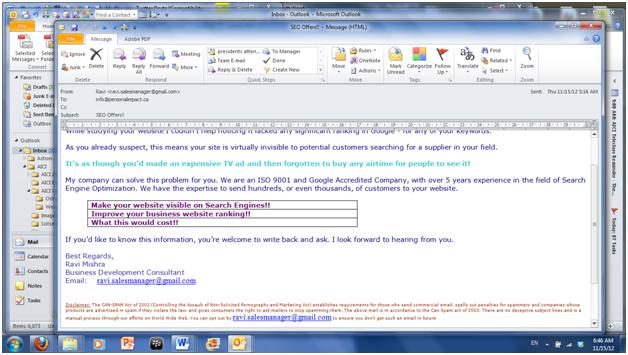 This email signature lacks credibility. Other then the person’s name, it does not tell me anything about the person or the company they work for.
This email signature lacks credibility. Other then the person’s name, it does not tell me anything about the person or the company they work for.
The signature below provides credibility to the company. There are no secrets.
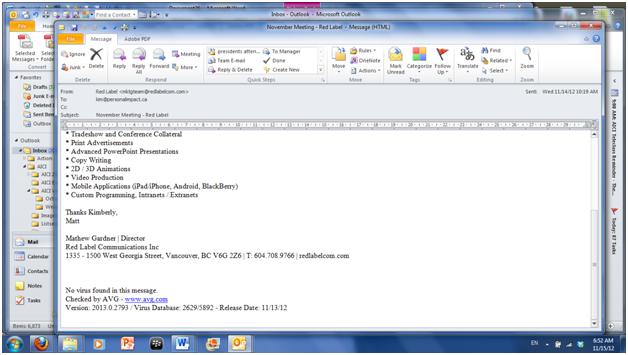 A good email signature should include the following information:
A good email signature should include the following information:
Providing full information provides the potential client the opportunity to research your company before contacting you. This also provides reassurance to your potential client that you, your company and the product or service you are offering are credible.
Your personal image consultant,

The shoes you wear can have a major effect on how slim or wide your feet look. The trick is the simpler the shoe and the more front to back details like a long opening or (vamp), the slimmer your feet will look. To widen your feet add extra colours, details, texture and horizontal lines like a square toe.
